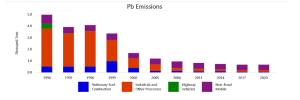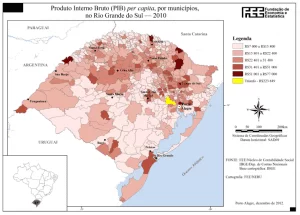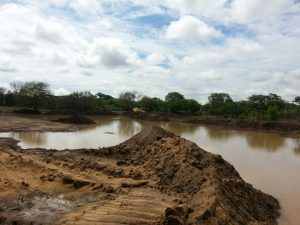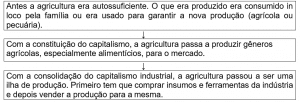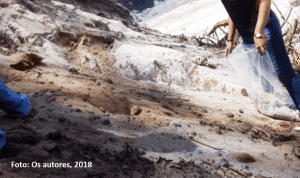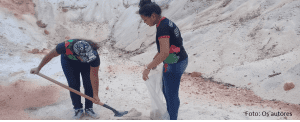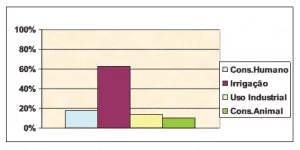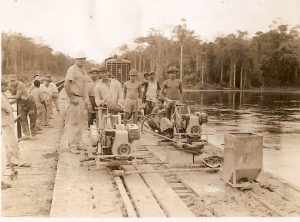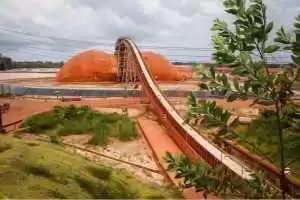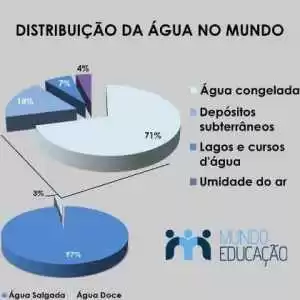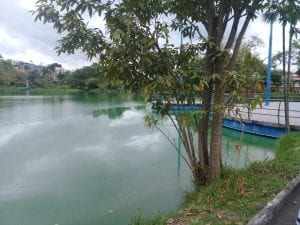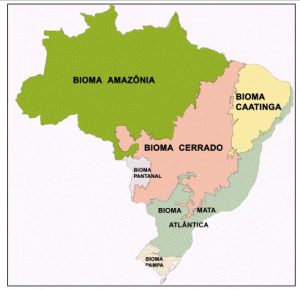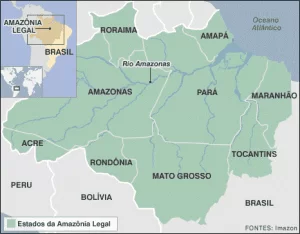OLIVEIRA, Euzébio de [1]
OLIVEIRA, Euzébio de – Socioeconomic and environmental characterization in a Coastal Community in the Amazon region, Pará-Brazil Magazine Multidisciplinary Scientific Knowledge Center, Year 1, vol. 4, pp. 21-34 – July 2016 – ISSN:0959-2448
SUMMARY
This study was carried out in Acarajó, a community of agro-pesqueira Marine PROTECTED AREA Caeté-Taperaçu, located in the coastal plain Bragantina, Northeastern Pará State (Brazil). The objective of this study was to evaluate the social, economic aspects and the environmental degradation factors of that community. For this study we used methodologies based on interviews, questionnaires, direct observation and measurement of potential environmental degradation factors. In relation to socio-economic aspects it was observed that Acarajó is one of the communities with the highest number of inhabitants, located in the area of the PROTECTED AREA, with mostly young people with low education and low monthly average income. In the community there are now better job opportunities and services and facilities available to the population are scarce or nonexistent. These factors contribute to the index of living conditions and housing to reach very low values, when compared with the minimum acceptable. In relation to environmental aspects, this community presents serious problems arising from the lack of basic sanitation (presence of too much garbage, lack of treated water, health problems, etc.), as well as in relation to degradation of natural resources (accelerated deforestation of mangrove vegetation, reduction of fish stocks and soil degradation). Finally, proposals for integrated coastal management measures were presented, in order to contribute to the improvement of the social and environmental quality of the area studied.
Key words: characterization. Socio-economical. Environment. Coastal Community.
INTRODUCTION
Coastal areas have always been places of great attraction to human populations, mainly due to the availability and abundance of natural resources, and the large tourist resorts, real estate, industrial, among others. Due to this fact, about 60% of the major urban centres are located in this region, a fact that affects in serious conflicts of social and environmental character (CHI et al., 2001; LIAO et al., 2003; KULLENBERG, 2001; BILLÉ; MERMET, 2002).
In Brazil, in the last few decades, the rapid population growth in these regions come several problems resulting from social and environmental character (Alheiros, 1995; Diegues, 1999). In this context, the northeast of the State of Pará is one of the most densely populated regions of the North coast of the country, and consequently, one of the most degraded of the region (SHAN-SON, 2001; SILVA et al., 2006; PARKER et al., 2006b; ROSE et al., 2006; PARKER et al., 2007).
In order to preserve the environment through the sustainable use of natural resources, as well as to protect the livelihoods and culture of traditional peoples there exist, in the year 2005, about Decree Law of the Federal Government, four Marine extractive reserves have been created in this sector para (MMA, 2005). Between these RESEX the Marine extractive reserve Caeté-Taperaçu, in which it is inserted the agro-pesqueira community of Acarajó (Henry 2005).
With the aim of contributing to the preparation of a management plan for this PROTECTED AREA, sought to meet the socio-economic and environmental dynamics of one of the most densely populated communities included in this conservation area. To achieve this goal, a study on the socio-economic profile of the residents of the community, the types of use and local territorial occupation, as well as the characterization and/or the measurement of the main potential factors of environmental degradation occurring in this area was carried out, in order to contribute to integrated management measures, seeking sustainable socioeconomic development of urban communities located in the Marine extractive reserve Caeté-Taperaçu.
MATERIAL AND METHOD
AREA OF STUDY
Acarajó is located at, approximately, 7 km from the town of Braganza and has an area of approximately 100.55 ha. Its geographical boundaries are: to the North on the community of Bacuriteua, to the South with the community of Avocado, to the East by the Caeté River (which flows into the Atlantic Ocean), and to the West with the communities of the Torch and Taperaçu fields (ADAMS; MACEDO, 2001) (Figure 1).
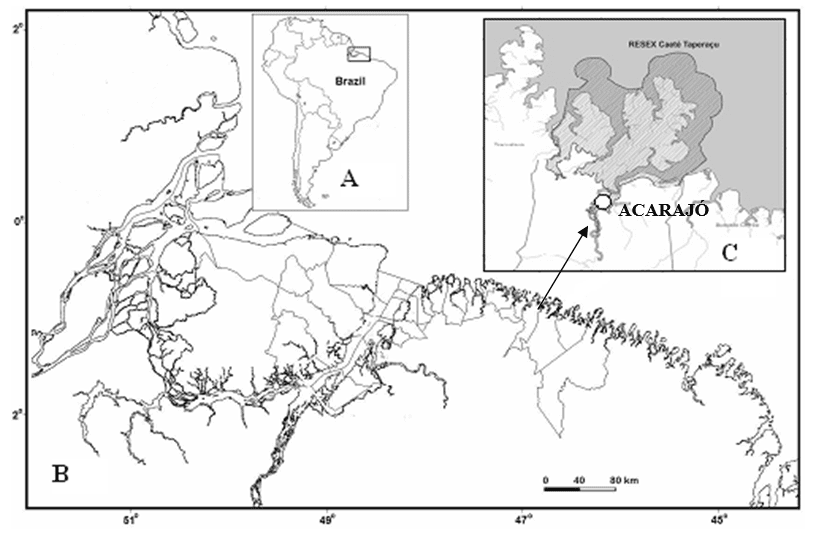
The Bragantina coastal plain is characterized by the occurrence of mangroves occupying 95% of the entire coastal area, and the mangrove forests composed basically by the species of Rhizophora mangle, Avicennia germinans and Laguncularia racemosa, and r. mangle the dominant species (BERGER et al., 1999; KRAUSE et al. 2001; PROISY et al., 2003).
The region’s climate is hot and humid, with a well-defined variation by presence of a dry period and another rainy. Annual average temperatures oscillate between 20.4 and 32.8° C, and relative humidity between 77 and 91% (INMET, 1992; MARTORANO et al., 1993).
Acarajó is one of the most densely populated communities agro-pesqueiras the Marine extractive reserve Caeté-Taperaçu, being composed of several local ecosystems, such as mangroves, land and Rainforest. The territorial occupation of Acarajó is another factor which distinguishes it in relation to other agro-pesqueiras communities of the region, since the occupation occurred on the banks of the PA-458, forming two local clusters, called Acarajózinho and Acarajó-Large; and one more into the area of the community, towards the Caeté River estuary, known as Acarajó (SAINTS, 1996).
METHODOLOGY
Semi-structured questionnaires, interviews, direct observation and measurement of the main factors of environmental degradation have been conducted between the months of May/2006 to February 2007, to characterize the socio-environmental conditions of the community under study.
Semi-structured questionnaires consist of three blocks of questions (socio-economic profile, condition of life and housing and opinion and perception of the residents about the environmental problems) have been applied in 100% of the residences, during the months of July and August 2006. The socio-economic profile of the residents raised information on sex, age, occupation/profession, income, marital status and educational level.
To determine the condition of life and housing of the inhabitants of each residence was necessary to calculate the index of living conditions and housing (ICV-MO) according to the methodology described by Costa (2004), following the pattern used by the socio-economic development index, developed by the Foundation of Economics and statistics (IDESE/FEE) through the formula (ICV-MO = (p1 x IAF) + (p2 x ISP) + (p3 x IP)) , the IAF, the index of the physical aspects of housing; the ISP, the index of public services available to the community; and the IP, the Situation of the property index.
The types of infrastructure and services available to the Community (health, sanitation, education, transport, etc.) were identified through direct observation, following the checklist methodology applied by Junyent (1999) and Pereira et al. (2003), as well as through interviews.
The questionnaires intended for opinion and perception of the residents about the environmental problems have been drawn up in accordance with the work of Morgan et al. (1993), Morgan et al. (1995) and Leatherman (1997) and adapted to the local reality. These questionnaires were applied to a member of each residence.
After the opinion and perception of residents about environmental problems, as well as direct observation regarding the infrastructure and services available, and the environmental condition of the community, specific methodologies were adopted to measure/analyze some environmental problems pointed/detected, as the accumulation of domestic waste, water quality, deforestation and land use for agriculture. The methodology used below:
(i) production of household waste: was first analyzed the fate given to garbage (collected by the city, burned, buried, dumped in vacant lots, fields, etc.) Then, the job of measuring the garbage was carried out by means of two samples, one at the end of September and the other at the beginning of the month of November/2006, each sample represented by waste produced during two days in 30% of the total number of houses in the community. Based on the average of the two samples was estimated production of monthly garbage to 100% of the residences in the community. Each sample collected the organic waste (unrecycled) was heavy separately from inorganic garbage (recyclable), then analysis of variance were performed (beginning and end of the month). To determine the normality and homogeneity of the data was performed the Lilliefors test (CONOVER, 1971) and Bartlett’s (SOKAL; ROHLF, 1969), respectively, with the aid of the program STATISTICA 6.0 (STATSOFT, 2001). When the data have not been normal, log transformations were used (x + 1). For normal data was applied to analysis of variance (ANOVA-one-way), followed by post-hoc test Fisher LSD. But when the variances were heterogeneous test was applied non-parametric Mann-Whitney test (U). In both cases, the households studied were grouped according to the number of inhabitants. The works were carried out based on the corporate commitment to Recycling manual (1995), and the Integrated Solid Waste Management manual in the Amazon (IBAM, 2005), being both methodologies adapted to the local reality.
(ii) water quality: the collection of the samples was carried out during the dry period (November 2006) and the rainy season (March/2007) in two community wells (groundwater extracted by tubular shaft) community, being Well located 1 46 46 ‘ 7. 416 ” W-1 0 ‘ 23,519 ” S and 2 well in the 46 46 458 Highway ‘ 26,852 ” W-0 ‘ 1 ” S 21,359. These wells were chosen because they are among the main water supply wells, serving a large number of residents of the community. All physicochemical analyses were performed in the laboratory of Estuarine and coastal Oceanography of the UFPA, following methodologies and/or equipment specific to each component being studied: the actual color and apparent analyzed by Color of water equipment HI 93727 Hanna Instruments, the turbidity Turbidity Meter HI 93703 Microprocessor by Hanna Instruments, the material in suspension, the Strickland and Parsons (1972) the pH by Labmeter model pH2-pHs-3B, the salinity by Multianalizador Corning Checkmate II, the iron dissolved by Hardness & Iron HI 93741 Hanna Instruments, the faecal coliforms and totals analyzed from the technique called multiple tubes, following the methodology adopted in the American Public Health Association (2004), and the temperature by the Thermometer Incoterm L-168/04. For the classification of water quality, the procedures were carried out using the parameters laid down by specific resolutions, according to ANVISA (2004); CONAMA (1986, 2000, 2005) and SSC (2006).
(iii) Deforestation (logging): was measured based on the answers obtained by interviews and questionnaires with residents of the community, in which were discussed questions related to the extraction plant (cut or mangue), as well as through direct observation held during the month of August 2006. This work was based on the method of Greenwood (1973), which consists in intensive and varied analysis unit/object of study.
(iv) land use for agriculture: through questionnaires and direct observations were identified the areas of cultivation, types of farming practices and soil management techniques more employed in the community under study, such as the form of plowing the land, use of pesticides and fertilizers; cut down of capoeira and burned. This work was conducted during the month of August 2006, following the method of Greenwood (1973).
RESULTS AND DISCUSSION
SOCIO-ECONOMIC CHARACTERISTICS
The census in Acarajó showed that 358 families (a total of 1696 individuals, i.e. 4.74 people per house) inhabit one of the largest communities in number of inhabitants, the RESEX Caeté-Taperaçu. Most residents are male (52%), aged between 0 and 20 years (55%), consisting of singles (62%) and students (36%), with a low degree of education, and 55% receive less than one minimum wage per month (R$380,00 *)
Among the activities of occupation, family agriculture appears first, being intended for the subsistence of the family group. However, fishing, crab Ucides cordatus primarily, is considered one of the main sources of income of local residents (Henry 2005).
Low schooling, alternative jobs, low income and the predominance of large families are factors that contribute to a low socio-economic development in this community. These aspects are similar to those seen by Krause and Glaser (2003), Guimarães (2005), Silva et al., (2006), Pereira et al. (2006a) and Pereira et al. (2006b), which carried out similar studies in other agro-pesqueiras communities in the region, a fact that demonstrates a generality in relation to socio-economic conditions in the coastal region.
LIVING CONDITIONS AND HOUSING/INFRASTRUCTURE AND SERVICES
In relation to the index of living conditions and housing ICV-MO, the community of Acarajó presents an average index 0.638, being below the minimum acceptable conditions for coastal communities, which is 0.707, according to socio-economic development index created by the Foundation of Economics and statistics (IDESE/FEE). Of households surveyed, only 29% is above the minimum acceptable index, showing an average of 0.759.
This index reflects the conditions of the construction of the houses of the Community (physical and health aspects) and the lack of services and infrastructure available. This community also features a considerable number of houses of clay, covered with dried palm leaves, with dirt floors, no possessing bathroom or sewer system, in which some have problems related to water supply.
With respect to public services available it was observed that the community does not have a public system of drinking water supply, the supply being accomplished through community wells. The water is distributed through pipes to households, with each House that adheres to this system pays a fee of 10.00 R$ reais a month (for the Association) for use of the water. On the other hand, some locals claim that this “system” of water supply does not work regularly.
With respect to education, Acarajó has three elementary schools less, thus students who need to continue your studies need to move up to school in the municipality of Bragança.
The community does not have any public health center, and in mild cases, the care of community agents receive community that regularly visit the homes. In cases of more severe diseases or accidents, residents seek medical care in the clinic located in the neighboring community of Bacuriteua, or go to the health centers and/or hospitals in the municipality of Bragança and Bethlehem. According to the community, the higher incidence of diseases are: malaria, flu, fever, diarrhea, skin diseases, among others, to the malaria disease which most affect the residents.
OPINION AND SOCIAL AND ENVIRONMENTAL AWARENESS
With respect to the opinion and the perception of the residents regarding the main environmental problems that have been taking place in the area of the community, the data obtained show that Acarajó faces problems related to issues of sanitation (lack of a garbage collection system, lack of treated water and sewer system), the degradation of natural resources (overfishing, deforestation of mangroves , reduced soil fertility, etc.), among others (table 1).
Table 1. Main environmental problems pointed to by the Acarajó community.
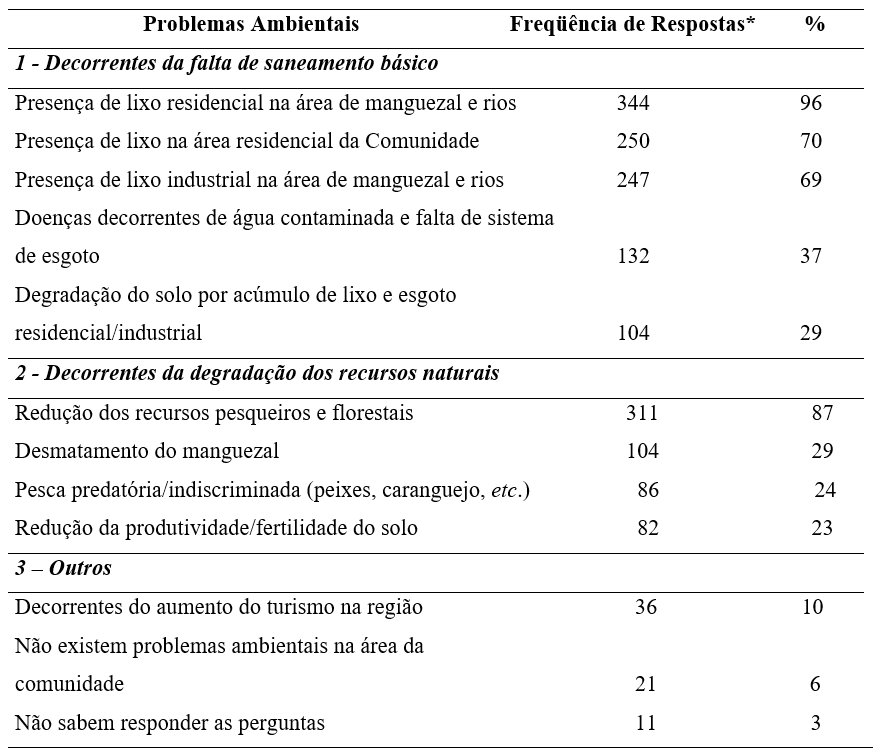
Problems arising from the increase in tourism in the bragantina region were also singled out by the community, since it is located on the access road to the beach Ajuruteua (BP-458), and between the June and July period increase of garbage along the highway is one of the problems troubling local residents. These problems are worsening as a result of the neglect of the local authorities to encourage tourism in the region, without first conducting a rational planning on using and the territorial occupation (GUIMARÃES, 2005).
Another problem related to the garbage, according to residents, are waste products released by fishing factories along the Caeté and surrounding areas. According to work done by Krause and Glaser (2003) and Silva et al. (2006), the problem in relation to the production of garbage, so much as in the industrial agro-pesqueiras residential the Bragantina coastal plain is a serious issue, and should be treated with seriousness, as well as environmental damage, can cause problems related to human health.
According to residents, some diseases such as fungal infections, dengue fever, leptospirosis, etc. are related to the accumulation of garbage in the area of the community. Other diseases that occur in the locality and which are related to the lack of a basic sanitation system, as well as deforestation, are also considered of concern on the part of the population, such as malaria.
On the other hand, degradation of natural resources e.g. overfishing and the felling of mangrove forest, have also been identified as environmental problems, according to the perception of the residents. According to these, overfishing and deforestation occur as a result of the scant oversight by the competent bodies, a fact that comes from subsistence fishing commitment of many local families.
PRODUCTION OF HOUSENHOLD WASTE
Based on data obtained by direct observation, as well as by the information passed on by residents it is possible to say that the Acarajó community has been facing a serious problem in relation to the production of garbage. The data show that the system of garbage collection performed by the City Hall of the municipality of Bragança is deficient because it does not meet all the community occurs only three times a week and just off highway Bragança-Ajuruteua beaches. As a result, many residents throw their garbage in backyards of their homes, streets, Caeté, estuary creeks, mangrove forest, brushland, etc., causing serious social and environmental character, such as contamination of soil, water resources, human health, aesthetics, etc.
In relation to the work of measurement, the results showed that the average monthly production of household waste by the community of approximately 5,029.375 kg, with a per capita monthly production of about 2.965 kg, being ± 0.099 kg/day per person. According to the IBAM (2005), these values are below the national average, in which per capita production is the 0.700 0.450 kg/day. The production of organic waste not varied much during the month, remaining virtually unchanged in both collections, on the other hand the inorganic garbage suffered significant variations (F = 6.59; p = 0.0090) in its production during that same period, demonstrating higher values at the beginning of the month studied.
However, organic waste were the main components of the trash analyzed, representing 53% of the total, being composed mainly of leftover food and fruits peelings (Figure 3A). These data are similar to national data, which organic matter is a major component of household waste produced in the country, representing on average, about 65% of the total (, PARSI, 1996; IBAM/MMA, 2005). This is probably due to the fact that this community be more “urbanized” being closer to the city of Bragança, and reuses the organic waste produced as a source of food for small animals (duck, chicken, etc.), which occurs in most rural communities in the region. On the other hand, of the total inorganic garbage analyzed, plastic represents 43 percent, followed by paper/cardboard with 27%, and 8% Tin, among others (Figure 3B).
Over the 25 km route from the coastal plain Bragantina, there was no system of garbage collection, which is deposited in the coastal environment, thus constituting a serious threat to the ecosystems present (SOUZA-FILHO, 2001). This is not a fact that has occurred only in the bragantina region as Silva (2006), one of the biggest problems of today, that has concerned both scholars of environmental issue, as planners and public managers from various parts of the world, concerns the problem of the garbage produced in urban areas or nearby locations at cities, as well as to the fate of same.
According to Valente and Grossi (1999), in Brazil, the garbage problem is very complex, because in many cities the majority of municipal solid wastes are deposited in the open, in rivers, estuaries, lakes, etc., which may cause contamination of soil, water resources and generate aesthetic issues and to human health.
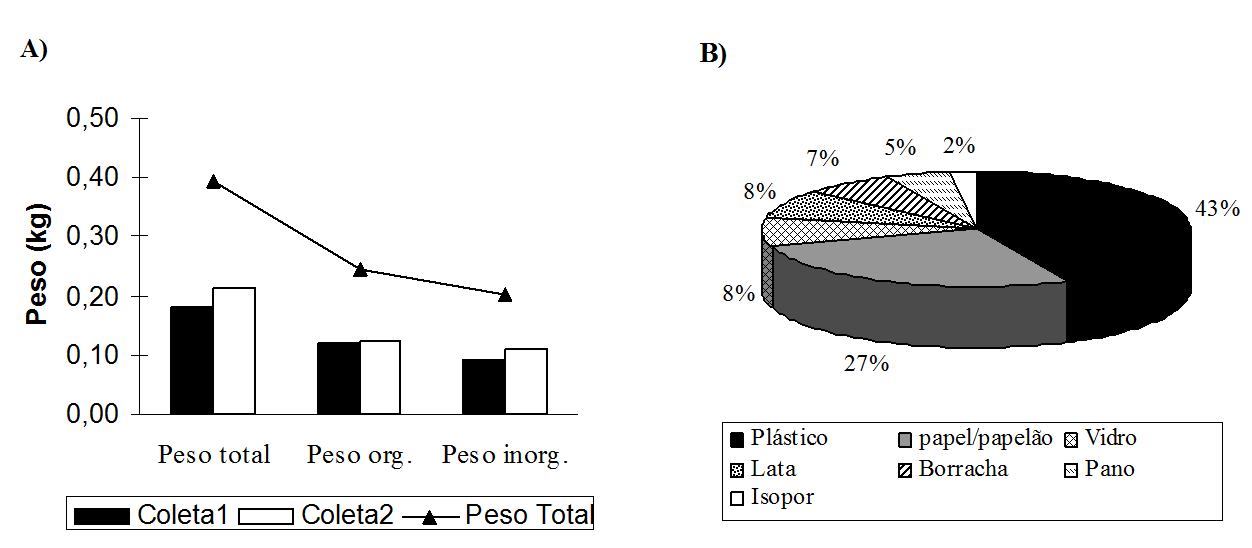
QUALITY OF WATER FOR CONSUMPTION
The groundwater is of great importance in economic terms and social health for urban populations throughout the world. There are no exact statistics regarding the volume of water used for public water supply from underground capture, although something around 50% of all the water consumed in the urban world is captured in wells and/or sources (CLARKE et al., 1995).
However, the concern with water quality is a fact, as most of the researches developed previously, only aimed at quantitative aspect. However, with the population growth, with industrial development and water resources utilization of the super, the quality factor has become very important (MOTA, 1995). Thus, it is essential that water resources present conditions appropriate to the physical and chemical use of living beings, and contain substances that are essential to life and be free of other substances that can produce effects harmful to organisms (BARNES et al., 2003).
The results obtained for the analysis of physical and chemical parameters of the water supply in two wells of Acarajó community are shown in table 2.
Table 2. Physico-chemical analysis of the water in two wells in the community of Acarajó, dry and wet periods.
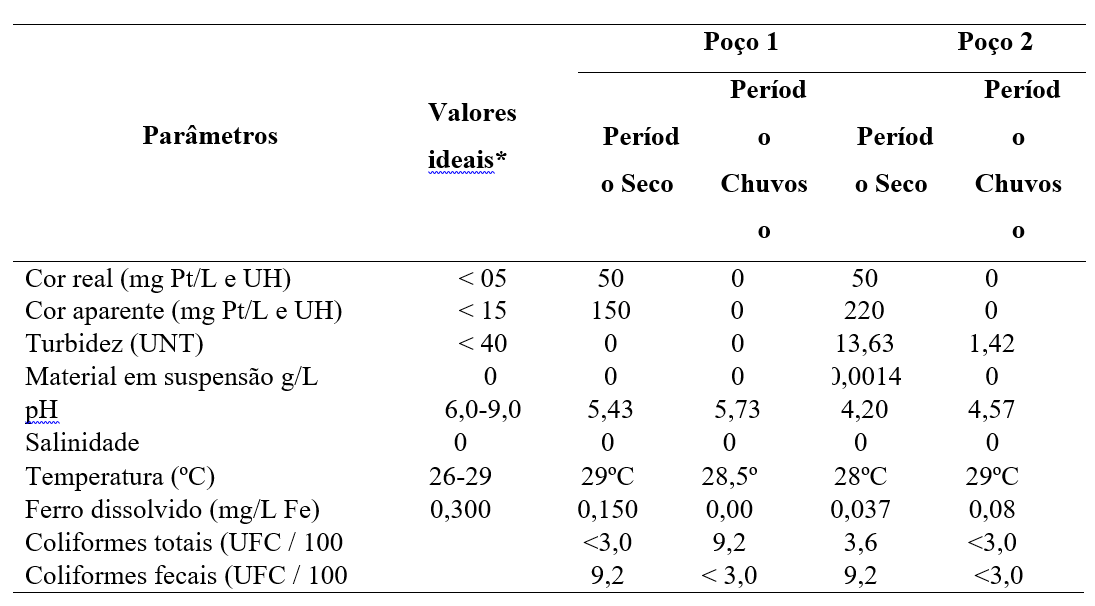
According to table 2, it can be observed that the values of the actual color and color apparent are above the maximum values allowed by the law, in both the points examined during the dry period. This is probably due to increased turbidity, the concentration of organic material in suspension and the increase of the concentration of dissolved iron in the water during this period. However, this increase in organic material in suspension, dissolved iron as well as turbidity, even reporting higher in dry period, are still within the parameters established by the specific resolutions.
The pH observed appeared slightly acidic, in both points and analyzed periods, not suffering major changes from one period to another, and according to data obtained by Walker (1995), in other regions of the Amazon, where there is verified evidence that variations in pH of water are independent of the pluviometric regime.
However, it is noteworthy that the salinity is one of the parameters responsible for the acidity of a water body, but that in this study this parameter obtained values 0 (zero) in all the analyses show that the acidity of this water must be related to other factors. According to Souza and Tundisi (2000), the chemical composition of the water varies greatly and is controlled by a number of factors such as climate, vegetation, topography and geological features, as well as by human activities. In the studied area, the acidity of the soil can be one of the factors that acidifies the water analyzed (see item 4.5.7)
The total and fecal coliforms showed high values, compromising the quality of that community water ´ d, because in both points and analyzed periods, the amounts recorded were above those tolerable according to specific resolutions (ANVISA, 2004 and of CONAMA, 1986, 2000 and 2005). According to CETESB/SP (1992), the presence of total coliforms in water indicates the possibility of fecal pollution of this, since such micro-organisms can be found freely on the environment. However, the presence of faecal coliforms determines the origin of fecal contamination, indicating risk of presence of other pathogenic micro-organisms, making the water unfit for human consumption (PELCZAR JUNIOR; CHAN; KRIEG, 1996; BASTOS; ADAMS, 2000). These results are in agreement with studies by Glaser (2003), in other communities of the coastal plain, where they found the Bragantina presence of fecal coliforms in the water in a large number of households and schools of these communities.
DEFORESTATION
According to the results obtained, extractivism vegetable (use mangrove wood and poultry) is a consistent practice in the area of the community of Acarajó. In particular, the three species of mangrove trees in the area are Rhizophora mangle l., Laguncularia racemosa and Avicennia germinans, and are subject to uncontrolled application of the techniques of extraction.
At least 68% of households (homes) surveyed stated that they pull out mangrove wood and/or capoeira, and of these, 55% perform the cut tree, total 27% partial cutting (only branches) and 18% use other methods, such as the collection of branches and trunks. According to the residents, among the multiple uses that they make of wood collected include: domestic consumption (85%), domestic consumption and the production and sale of coal (12%), and the production and sale of coal (3%).
However, due to the fact that the majority of housing in this community has wood burning stoves, it is estimated that the percentage of homes that use mangrove wood and/or capoeira as fuel, is even greater. Studies conducted in Mexico, by Maseral et al. (1997), and in El Salvador by Gammage et al. (2002) show that the consumption of firewood for home use in a socioeconomic context similar to that existing in the study shows that at least 90% of these homes depend on the wood that is withdrawal of forests, to be used for household fuel (firewood).
According to the villagers of Acarajó, withdrawal practices of mangrove wood and/or capoeira, as well as the production of coal are preferably made during the dry season. The collected wood and coal (when produced) are stored to be used and/or sold (coal when appropriate), especially during the rainy season, once during this period, the practice of removing the wood and charcoal production, become more difficult to be carried out. For Dahdou-Guebas et al. (2000), the practice of production and sale of charcoal is a very common activity in populations that live in the mangrove areas, as this becomes an important source of income for the poorest inhabitants of these areas.
The practice of cutting of mangrove trees for commercial purposes is another factor of degradation that has taken place in the area of the community. However, this type of cut is not explicitly by the people who practice it, and it is easy to be perceived, because when the timbers are exposed on the highway PA-458, is not generally responsible for the withdrawal, and this fact occurs for fear of denunciations and sanctions. On the other hand, the areas that are being cleared are difficult to access.
According to work done by Glaser et al. (2003) many lumberjacks are also crab pickers and depend on the preservation of mangrove area. This fact comes favoring that many local woodcutters working in the cutting of mangrove in other communities the Bragantina coastal plain. The strategy used for cutting is quite planned being the practice held during the evening, especially on weekends and holidays to reduce the risk of being intercepted by public authorities. The range of vegetation located near the banks of the River are maintained, to delay the detection of activity. The speed is also considered essential, to decrease the risk of conflicts between the team and local residents.
The overthrow of mangue works within a classical relationship of employer-client (KATON et al., 1998; FOELL et al., 1999; TÊVES, 2000). After cutting, timber is transported to the city, usually having your destination (client) right. This is mixed with other wood cut “legally”, with the aim to hinder identification, and so are sold for use in construction, or preferably in the form of firewood to potteries and bakeries in the area.
However, note that, generally speaking, the population resident in the study area, is aware of the importance of the mangrove ecosystem there, because their livelihood also depends on the local extraction and sale of mangrove products on a small scale, as for example, the crab, and the charcoal produced from the wood extracted from mangroves. These techniques are clearly related and complex strategies of livelihood of the poorest (GLASER, 2003). On the other hand, see deforestation of mangrove community, on a commercial scale, as a serious environmental problem because this degradation can cause serious impacts to the environment and, consequently, in their way of life, compromising even their own survival.
Finally, it is noteworthy that the illegality makes it impossible to further scientific research and the application of proven techniques of sustainable forest management, such as the overthrow directional, using more complex of trees cut, rotating collections and planned, and the replanting. These are methods of forest management and can be applied, which could greatly contribute to increasing the sustainability of cutting in the study area.
LAND USE FOR AGRICULTURE
Historically, the residents of the Acarajó community always have developed two types of land use for agriculture, being the cultivation on land for planting manioc/cassava products (Manihot esculenta), corn (Zea mays), Cowpea (Vigna unguiculata), etc.; and in mangrove areas for rice cultivation (Horyza Sativa). It is noteworthy that the activity of rice production has played a central role among the economic activities of the community of Acarajó, where in addition to being the base of power, was also the main source of income of the residents of this community (CANELLES, 2001). Currently, rice began to be cultivated for subsistence, supplying the needs of family power, as well as for the maintenance of local tradition to the annual Rice Festival (CANELLES, 2001).
On the other hand, dryland farming is very much up to the present day, covering several areas of land that are used for growing, becoming one of the main forms of subsistências for at least 52% of the people who live there.
For the cultivation of the soil, the residents of the Acarajó community carry out itinerant agriculture, i.e. a management based on traditional methods, which consists in overthrowing and burning of capoeira to the preparation of the Earth (SANCHEZ, 1979; SMITH; BASTOS, 1984; KATO, 1988). For deployment of crops in the area of the community, the tasks are all carried out manually, with the use of just terçados and hoes and have members of the family, the main source of labor. In these areas, generally, are cultivated beans, manioc, corn, among other crops.
In this system after a few years of cultivation, the ground is abandoned for the regeneration of a secondary forest (capoeira), being subsequently used after several years of fallow (rest of the solo) (Sánchez, 1976). In the present study it was found that the fallow, lasts on average 5 years, and after this period, the soil is used. According to Smith and Bastos (1984), the set-aside system, for forest regeneration, allows accumulation of nutrients in the soil biomass, aiding in his recovery of fertility. However, this requires a large period of time, which according to rooms and Folster (1976) can take up to 16 years for the soil again nutrients equivalent to primary forest.
According to over 50% of farmers, the extractive soil productivity has decreased in recent years, independent of the usage roller is made between the cultivated areas. This has contributed to the increased use of fertilizers and pesticides in farming areas, where about 30% of farmers already makes continued use of these products. This fact is worrisome because overuse and gradual of fertilisers and other chemicals contribute to the degradation of the soil and the water. Between the 70 and 90, the global use of fertilizers has increased to an annual average of 3.5%, i.e. more than 4,000,000 tonnes per year (FAO, 2001).
Table 3 presents the results obtained as a result of the chemical analysis performed on a Yellow Latosol, Acarajó community.
| Use soil | Ph H2O | Ph KCl | (C) | MO | P | |||||
| ———–g/kg soil———- | mg/dm3 soil | |||||||||
| Prof. 0.00-0.05 m | ||||||||||
| Use 1
Use 2 |
4.4 the
4.8 the |
3.9 the
3.8 the |
19.5 b
28.8 the |
b 33.6
the 49.7 |
8.6 the
4.3 the |
|||||
| Prof. 0.05-0.10 m | ||||||||||
| Use 1
Use 2 |
4.4 the
4.7 the |
3.9 the
3.7 the |
20.2 the
26.3 the |
34.8 the
45.3 the |
8.3 the
3.0 b |
|||||
| Prof. 0.10-0.20 m | ||||||||||
| Use 1
Use 2 |
4.5 the
4.7 the |
3.9 the
3.8 the |
21.9 the
21.5 the |
37.8 the
37.1 the |
8.4 the
2.4 b |
|||||
| Use soil | K | CA | Mg | Al | H + Al | |||||
| ————————————- cmolc/dm3 solo ——————————– | ||||||||||
| Prof. 0.00-0.05 m | ||||||||||
| Use 1
Use 2 |
0.09 the
0.08 the |
0.82 to
0.83 a |
0.49 to
the 0.53 |
1.64 the
1.62 the |
9.51 the
11.18 the |
|||||
| Prof. 0.05-0.10 m | ||||||||||
| Use 1
Use 2 |
0.07 the
0.05 to |
0.81 to
0.38 b |
0.51 to
0.49 to |
the 1.63
the 1.91 |
9.60 the
the 10.93 |
|||||
| Prof. 0.10-0.20 m | ||||||||||
| Use 1
Use 2 |
0.07 the
0.04 the |
1.12 the
0.46 b |
0.36 to
0.33 to |
1.58 the
1.71 the |
9.13 the
9.26 the |
|||||
| Use soil | SB | CTC | CTC effective | V | m | |||||
| ——————-cmolc/dm3 solo————- | —————- % ————– | |||||||||
| Prof. 0.00-0.05 m | ||||||||||
| Use 1
Use 2 |
1.40 the
1.42 the |
the 10.91
12.62 the |
3.04 the
3.05 the |
14.3 the
11.5 the |
51 the
53 the |
|||||
| Prof. 0.05-0.10 m | ||||||||||
| Use 1
Use 2 |
1.39 the
the 0.92 |
the 10.99
11.85 to |
3.02 the
2.82 the |
14.0 the
7.9 b |
53 the
68 the |
|||||
| Prof. 0.10-0.20 m | ||||||||||
| Use 1
Use 2 |
1.35 the
0.83 a |
the 10.68
10.09 the |
3.13 the
2.54 the |
15.7 the
7.8 b |
51 the
70 the |
|||||
Analyzing the table 3, it is observed that both the pH in H2O, as the pH in KCL, varies from 3.7 to 4.8 in both uses and that there is too much variation between the depths. These data confirm the extremely acidic character of this type of soil present in the Amazon region (EMBRAPA, 1999).
So many levels of carbon (C) as the organic matter (MO), appear in high concentration, increasing with depth 1 use (farm) and decreasing with depth in using 2 (capoeira) (table 3). This higher content of these components, found on the surface (use 2) is due to the incorporation of vegetable residues from the agroforestry system there. The maintenance of soil organic matter levels is an essential factor for the preservation of the physical, chemical and production of plants in tropical soils (TISDALL; OADES, 1982; ZECH et al., 1997).
The highest values of phosphorus (P) (table 3) and the sum of the bases (SB) (table 3), on the road surface in both uses, can be attributed to higher levels of organic matter in the surface due to the natural fertilizing (usage 2) or successive fertilization, reflecting the cumulative effect of the application of fertilizers (use 1). These results are similar to those that Marques et al. (2004) observed in similar studies carried out in the region of Manaus (Amazon).
The levels of potassium (K) were low in both uses, and with a few variations in declining all depths. However that change is not considered significant. Similar results were also found for calcium (Ca). Magnesium (Mg) showed median levels in both uses and in two more superficial layers (0-5 and 5-10 cm), showing low levels in the last layer. According to Demattê (1988), after firing and the introduction of agricultural practices, K levels increase, as can be noticed in this study (1), however, this one lasting increase.
Aluminium (Al) offers high levels of concentration in both uses and at all depths. Usually soils with pH too low, as is the case of this study, soil toxicity by aluminum, and therefore high saturation by aluminum (m%), high sum of exchangeable bases (V%), as well as low effective CTC. Both use 1 solo, how to use 2 feature moderate CTC values. The values of H + Al reveal some differences between the shapes and depths studied. The highest levels were observed in soils of use 2 (capoeira), indicating once again that these are very acidic and feature Al toxicity, showing in this way, a great restriction on the fertility. These results are in agreement with the observations of Smith (1996) studied the fertility of soils in the Amazon region used for sustainable production.
In General, it is possible to say that the usage was more 2 soil nutrient availability for plant absorption. The management of the soil through vegetal covering (capoeira) provided some changes in soil chemical properties: such as the increase in pH in H2O, the sum of the bases and available phosphorus, as well as increased levels of organic matter and carbon. You can also check that changes in vegetation cover, i.e. the removal of capoeira to the land use for agriculture caused decrease in levels of C and MO, in which these variables were quite vulnerable to cultivation, mainly, because they are typically more concentrated on the most superficial layer of the soil. Second Primavesi (1987), these lower concentrations of nutrients, presented in soils used for agricultural cultivation, under tropical ecosystems, are due to intensive leaching that occurs in these environments, as well as the type of employee management.
CONCLUSION
According to results presented in the course of this study, it can be concluded that the main problems existing in the environmental area of the community focus on two main aspects: the lack of services and infrastructure (mainly, the lack of basic sanitation) and the degradation of natural resources (reduction of fish resources and forestry, mangrove deforestation, reduced soil productivity, etc.).
Within that context, to contribute to the reduction and/or mitigation of such problems, it is suggested the implementation of programs/plans Integrated management, from measures aimed at the solution of these problems through education, awareness and planning of the multiple existing economic interests in that area. On the other hand, these recommendations can also help with the Coastal Zone Management Program in the State, because it presents some difficulties in its implementation. Among the measures to be taken can be highlighted:
- Improve the services and infrastructures (treated water, garbage collection, sewage treatment systems, improvements in health services).
- Generate new forms of work and/or programs in the context of socioeconomic sustainability, as (i) establishment of selective trash collection, aimed at recycling and organic fertilizer by composting; (ii) sustainable use of natural resources: fish, crabs, mangrove forest.
- Encourage and invest in the creation of community associations to strengthen the local economic sectors, as well as strengthening the political participation in governmental decisions of interest to the community.
- Develop educational programs, geared to the environment and family health, stressing the importance of the preservation and conservation of the ecosystems there.
- Establish a strategy of integration between research institutions and the local community, developing actions in order to achieve solutions to the conflicts and/or problems arising from the use and ownership of natural resources.
It’s up to point out that those measures should be taken urgently, since most human impacts, which have been taking place in the area, can still be reversed. Second-Son (2001), to reduce the vulnerability and impacts in coastal areas, on the man-made processes, it is necessary to decision making and effective actions to remedy or mitigate the problems arising from this process, whose assignments are public sector (municipal, State and federal), and on the other hand there must be awareness and community collaboration by working together to accomplish these actions.
BIBLIOGRAPHICAL REFERENCES
ADAMS, m. & MACEDO, r. Study of the locale Acarajó. Partial Report. Bethlehem: MADAM, 2001. 86 p.
ALHEIROS, m. m. Some coastal environmental problems in the metropolitan region of Recife. In: Symposium on sedimentary processes and environmental problems in the coastal area northeast of Brazil, v. 1, 1995, Recife. Bulletin of Summaries. Recife: SBG NE Cores and BA/SE, 1995. p. 24-26.
AMERICAN PUBLIC HEALTH ASSOCIATION. Standard Methods for Examination of Water and Wastewater. Washington, D.C. 2004. Available in: <http: www.satndard.methods.org/articles.cfm=””>.</http:> Access in: 15 Apr. 2005.
BASTOS, g. d. & ALVES, t. d. b. bacteriological evaluation of the water used in dental equipment das clínicas UEFS. 2000. 62 f. Monograph-dentistry-Universidade Estadual de Feira de Santana, Feira de Santana. 2000.
BERGER, U.; GLASER, M.; KOCH, B.; KRAUSE, G.; LARA, R.; SAINT-PAUL, U.; SCHORIES, D.; WOLFF, M. An integrated approach to mangrove dynamics and management. Journal of Coastal Conservation, v. 5, p. 125-134, 1999.
BILLÉ, r. & MERMET, l. Integrated coastal management at the regional level: lessons from Toliary, Madagascar. Ocean & Coastal Management, v. 45, n. 1, p. 41-58, 2002.
BOVOLATO, l. e. Study of vulnerability to contamination of groundwater using the methodology “GOD” for the urban area of Williams Lake. In: Brazilian Symposium on water resources. João Pessoa, v. 1, p. 393-393, 2005.
BARNES, B.; ROBERTO, I.; CONEJO, J. G. L.; BARROS, M. T. L.; VERAS JÚNIOR, M. S.; PORTO, M. F. A.; NUCCI, N. L. R.; JAIN, N. M.; EIGER, s. Introduction to environmental engineering. 2nd ed. São Paulo: Prentice Hall, 2003. 305 p.
Brazil. National Agency of sanitary surveillance-ANVISA. Ordinance No. 518, of 25 March 2004. São Paulo, 2004. Available at: <http: e-legis.bvs.br/leisref/public/showact.php.=””>accessed: 02 Apr.</http:> 2006.
Brazil. National Environmental Council-CONAMA. Resolution No. 20 of 18 June 1986. Available in: <http: mma.gov.br=””>.</http:> Access in: 02 Apr. 2006.
Brazil. National Environmental Council-CONAMA. Resolution No. 274 of 29 November 2000. Available in: <http: mma.gov.br=””>.</http:> Access in: 02 Apr. 2006.
Brazil. National Environmental Council-CONAMA. Resolution No. 357 of 17 March 2005. Available in: <http: mma.gov.br=””>.</http:> Access in: 02 Apr. 2006.
Brazil. Brazilian Agricultural Research Corporation-EMBRAPA. National Research Center of soils. Manual of methods of soil analysis. 2nd ed. current. Rio de Janeiro, 1997. 212 p.
Brazil. Brazilian Agricultural Research Corporation-EMBRAPA. National Research Center of soils. Brazilian system of soil Classification. Rio de Janeiro, 1999. 412 p.
Brazil. Brazilian Institute of Municipal Administration-IBAM. Integrated solid waste management in the Amazon. The methodology and the results of its application. Ministry of the environment. 2005. 73 p.
Brazil. National Institute of meteorology-INMET. Climatological normals 1961-1990. Brasilia, 1992. 84 p.
Brazil. Ministry of environment-MMA. ARPA created 9,000,000 acres in full protection: Stop wins six extraction reserves, on the coast, on Marajó island and in the Southern State, 2005. Available in: <http: www.mma.gov.br=””>.</http:> Access in: 14 Feb. 2006.
Brazil. Ministry of health. Health surveillance Secretariat – SVS. Sanitary Inspection in water/Ministry of health. Health surveillance Secretariat – Brasília, 2006. 84p. (Series A-standards and technical manuals).
CANELLES, c. b. study on rice culture in mangrove areas: the case of the community of Acarajó in the municipality of Bragança. 2001. 41 f. Final project-Federal University of Pará/NEISAF – Campus de Altamira, 2001.
CHAUVEL, A.; GRIMALDI, D.; TESSIER, d. Changes in soil pore-space distribution following deforestation and revegetation: An example from the central Amazon basin, Brazil. Forest Ecology and Management, v. 38, p. 259-271, 1991.
CHI, C.; HUTCHINSON, N. M.; YU, L.; XU, n. Towards a sustainable coast: an integrated coastal zone management framework for Shanghai, People’s Republic of China. Ocean & Coastal Management, v. 412, n. 44, p. 411-427, 2001.
CLARKE, R.; LAWRENCE, A. R.; FOSTER, s. s. d. Groundwater – threatened recourse. UNEP-Environmental Library, 1995. 15 p.
CORPORATE COMMITMENT TO RECYCLING. Product recycling. Rio de Janeiro, n. 4, p. 1-8, 1995.
Conover, w. j. Practical nonparametric statistics. New York: John Wiley, 1971. 302 p.
COSTA, a. a. in search of a strategy of transition to sustainability in Environmental System of small-scale fishing. 2004. 310 f. Master thesis-Fundação Universidade Federal do Rio Grande, Rio Grande, 2004.
DAHDOU-GUEBAS, F.; MATHENGE, J.; KOEDAM, n. Utilization of mangrove wood products around Mida Creek (Kenya) amongst subsistence and commercial users. Economic Botany, S.I., v. 54, n. 4, p. 513-527, 2000.
DEMATTÊ, j. l. i. management of acid soils of the humid tropics of the Amazon region. Cargill Foundation, Campinas, 1988. 215 p.
DIEGUES, a. c. Human populations and coastal wetlands: conservation and management in Brazil. Ocean & Coastal Management, v. 42, n. 2-4, p. 187-210, 1999.
FAO. Agriculture: Towards 2015/30. Technical Interim Report April 2000. Rome, Food and Agriculture Organization. 2001. Available in: <http: www.fao.org/es/esd/at2015/=”” chapter1.pdf=””>.</ht[Geo-2-167]tp:> Access in: 14 jun. 2006.
FOELL, J.; HARRISON, E.; STIRRAT, r. l. Participatory approaches to natural resource management: the case of coastal zone management in the Puttalan district. Sussex: School of African and Asian Studies, University of Sessex, 1999. (Summary finding of DFID funded research Project R6977).
GAMMAGE, S.; BENÍTEZ, M.; MACHADO, M. An entitlement approach to the challenges of mangrove Mau in El Salvador. AMBIO, S, v. 31, n. 4, p. 285-294, 2002.
GLASER, m. Interrelations between mangrove ecosystem, local economy and social sustainability in Caeté Estuary, North Brazil. Wetlands Ecology and Management, v. 11, p. 265-272, 2003.
GLASER, M.; BERGER U.; MACEDO, r. Site vulnerability as an advantage: mangrove forest management in Pará state, north Brazil, under conditions of illegality. Regional Environmental Change, v. 3, n. 4, p. 162-172, 2003.
GREENWOOD, e. de la investigación social Methodology. Buenos Aires: Piados Publishing House, 1973. 126 p.
GUIMARÃES, d. o. socio-environmental Aspects of beach Ajuruteua, Bragança-PA (Brazil): subsidies for the Integrated Coastal Management. 2005. 71 f. Master thesis-Federal University of Pará, Campus de Bragança, 2005.
HENRY R. Women and gender relations in fishing communities: the case of Acarajó (Bragança, Pará). In: GLAZER, M.; CABRAL, N.; RIBEIRO, A., (Org.). People, environment and research: transdisciplinary in mangrove management. Bethlehem: a/UFPA, 2005. p. 139-154.
IDESE, INDEX OF SOCIAL AND ECONOMIC DEVELOPMENT. Available in: <http: www.fee.tche.br=””>.</http:> Access in: 16 mar. 2006.
JUNYENT, m. v. Percepció dels estétics i mediambientals impacts de la regeneració de platges. 1999. 465 f. Thesis-Universitat de Barcelona. Espanya. 1999.
KATO, m. s. a. Fire-free land preparation as an alternative to slash-and-burn agriculture in the bragantina region, eastern Amazon: Crop performance and phosphorus dynamics. 1988. 144 f. Doctoral entitled dissertation. University Göttingen, 1988.
KATON, B. M.; POMEROY, R. S.; RING, M.; GARCES, l. Mangrove Rehabilitation and Coastal Resources Management Project In: Mabini-Candijay: A Case Study of Fisheries Co-management Arrangements in Cogtong Bay, Philippines. Fisheries Co-management Project. ICLARM, Manila, Philippines. 1998. (Fisheries Co-Management Research Project Working Paper 33).
KRAUSE, g. & GLASER, m. Co-evolving socio-economic dynamics and geomorphical in the coastal fishing village of the Braganza region (Pará, North Brazil). Ocean & Coastal Management, v. 46, p. 859-874, 2003.
KRAUSE, G.; SCHORIES, D.; GLASER, m. and SHEKHAR, k. Spatial patterns of mangrove ecosystems: the Bragantinian mangroves of North Brazil (Bragança, Pará). Ecotropica, v. 7, n. 1-2, p. 93-107, 2001.
KULLENBERG, G. Contributions of marine and coastal area research and observations towards sustainable development of large coastal cities. Ocean & Coastal Management, v. 44, p. 283-291, 2001.
LEATHERMAN, s. p. Beach rating: the methodological approach. Journal of Coastal Research, v. 13, p. 253-258, 1997.
LIAO, I. C.; SU, M. S.; LEAÑO, e. m. Status of research in stock enhancement and sea ranching. Reviews in Fish Biology and Fisheries, v. 13, p. 151-163, 2003.
MALAVOLTA, and agricultural chemical:. Handbook of plant nutrition and soil fertility. São Paulo, Ceres, 1976. 528 p.
MARQUES, J. D.; LANA, P. L.; TEIXEIRA, W. G.; RAHMAN, a. m. Study of physical, chemical and water parameters of a Yellow Latosol, in the Amazon region. ACTA amazonica, v. 34, n. 2, p. 145-154. 2004.
MARTORANO, L. G.; FERNANDEZ, L. C.; CESAR, E. G. M.; PARKER, i. c. b. climatological Studies in the State of Pará, climatic classification and water deficiency. Bethlehem: SUDAM/EMBRAPA, SNLCS, 1993. 53 p.
MASERAL, O.; NAVIA, J.; ARIAS, t. Linking analysis and intervention in the fuelwood systems of three micro-regions of Mexico. In World Forestry Congress, 11., 1997, Antalya, Turkey. Proceedings. V. 3, n. 16. Available in:<http:// www.fao.org/montes/foda/wforcon/public/v3/t16e/8-5.htm#top.></http:// www.fao.org/montes/foda/wforcon/public/v3/t16e/8-5.htm#top.> >. Accessed on 15 Sept. 2006.
MORGAN, R.; BURSALIOGLU, B.; HAPOGLU-BULLETS, L.; JONES, T. C.; OZHAN, E.; WILLIAMS, a. t. Beach user opinions and beach ratings: pilot study on the Turkish Aegean Coast. Medcoast ‘ 95. Spain, p. 373-383, 1995.
MORGAN, R.; JONES, T. C.; WILLIAMS, a. t. Opinions and perception of England and Wales Heritage Coasrt, Wales. Journal of Coastal Research, v. 9, p. 1083-1093, 1993.
Mota, s. preservation and conservation of water resources. 2. Ed. Rio de Janeiro: ABES, 1995. 200 p. Available in: <http: www.limeira.sp.gov.br=””>.</http:> Access in: 22 May 2006.
PELCZAR JUNIOR, M. J.; CHAN, AND C. S.; KRIEG, n. r. Microbiology of natural waters, drinking water and sewers. In: Microbiology: concepts and applications. 2. Ed. São Paulo: Makron Books, 1996. Cap. 29, p. 327-370.
PARSI, j. t. Composting Manual: low-cost process. Belo Horizonte – MG: UNICEF-Publisher, 1996, 56 p.
PEREIRA, L. C. C.; GUIMARÃES, D.; RIBEIRO, M. J. S.; COSTA, R. M.; SOUZA FILHO, p. w. m. Use and Occupation in Bragança Littoral, Brasilian Amazon. Journal of Coastal Research, SI, v. 50, 2007.
PEREIRA, L. C. C.; JIMÉNEZ, J. A.; MEDEIROS, C.; COSTA, R. M. The influence of the Environmental Status of Casa Caiada in Rio Doce beaches (NE, Brazil) on Beaches Users. Ocean Coastal Management & v. 46, p. 1011-1030, 2003.
PEREIRA, L. C. C.; RIBEIRO, M. J. S.; GUIMARÃES, D.; SOUZA FILHO, P. W. M.; COSTA, R.M. Forms of use and occupation in Ajuruteua beaches Beach-Pará (Brazil). Environment and development, SI, v. 11. In press, 2006a.
PEREIRA, L. C. C.; SOUZA FILHO, P. W. M., RIBEIRO, M. J. S.; PATEL, S. C. C.; NUNES, Z. M. P.; COSTA, r. m. socio-environmental Dynamics in Vila dos Pescadores (Eastern Amazon, Pará, Brazil). Environment and development, SI, v. 11. In press, 2006b.
PRIMAVESI, a. ecological soil management. São Paulo: Nobel, 1987. 541 p.
PROISY, C.; -SON, P. W. M.; FROMARD, F.; Prost, m. t. r. c. and MENDES, a. c. Monitoring the dynamic of the Amazon coast (Pará, Brazil and Frech Guyana) using the cammon methodology based on a special analysis coupled to simulate the tool. In: MANGROVE 2003, Salvador. Book of abstracts. v. 1, p. 459-459. 2003.
ROSA, L. N.; POMPEY, G. S. S.; BONAVENTURE, A. B.; AHMAD, S. L. F.; MODEST, R. S.; RAO, A.F. Characterization of farmers who have deployed Agroforestry in the municipality of Bragança. In: Annals of VI Brazilian Congress of Agroforestry Systems. Campos dos Goytacazes, RIO DE JANEIRO, 2006. Abstracts. (CD-ROM).
Salas, g. & FOLSTER, h. Bioelement loss on clearing tropical rainforest. Turrialba, Costa Rica, v. 26, p. 179-186, 1976.
SANCHEZ, p. a. Properties and management of soils in the tropics. New York, John Wiley, 1976. p. 346-412.
SANCHEZ, p. a. Soil fertility and conservation considerations for agro-forestry systems in the tropics of Latin America, In: MONGI, h. o. & HUXLEY, p. a., (eds). Soils Research in Agro-florestry. Nairobi, Kenya, International Council for Research in Agro-forestry, 1979. p. 79-124.
SANTOS, n. c. crab: a matter of survival in the community of Acarajó, Bragança-Stop. Bragança: a/UFPA, 1996, 57 p.
SÃO PAULO (State). Environmental sanitation technology company-CETESB. Total and fecal coliforms. Determination in water samples by membrane filter technique. NT. L5. 214. São Paulo, 1992.
SILVA JR, M. L.; MELO, V. S.; SCOTT, g. r. soil sampling Manual for fertility purposes. Belém: Universidade Federal Rural da Amazônia, 2006. 61 p.
SILVA, I. R.; PEREIRA L. C. C.; COSTA, r. m. use and occupation in a fishing community on the shore of the estuary of the rio Caeté (Pará, Brazil). Environment and development, SI, v. 11. In press, 2006.
SILVA, t. and m. 2006. Urban growth and the garbage problem: dilemmas and challenges. Available in: <http: www.posgrap.ufs.br/periodicos/pdf/art_soc_6_1.pdf=””>.</http:> Accessed on 20 June. 2006.
SMITH, t. j. soil fertility Management for sustainable production of crops in the Amazon. In: the soil in large areas of Brazil and morfoclimáticos sustainable development. Viçosa. Brazilian society of soil Sciences, p. 71-93, 1996.
SMITH, t. j. & BASTOS, j. b. Changes in fertility of a Yellow Latosol álico by burning vegetation. Brazilian Journal of soil science, v. 8, p. 127-132, 1984.
SOKAL, R. R.; F. J. ROHLF, Biometry. The principles and practice of numerical classification in biological research. San Francisco, California: w. h. Freemann, 1969. 776 p.
SHARMA, a. d. & TUNDISI, j. g. Hidrogeochemical comparative study of the Jau and Alligator-Guaçu River Watersheds, São Paulo, Brazil. Brazilian Journal of biology, San Carlos, v. 60, n. 4, p. 563-570, 2000.
-SON, p. w. m. natural and man-made Impacts on coastal plain of Braganza (NE), In: PROST, m. t. & MENDES, a. c. coastal ecosystems: impacts and environmental management. Bulletin of the Museu Paraense Emílio Goeldi. Belém, 2001. p. 133-144.
STATSOFT, i. n. c. STATISTICA (Data analysis software system), version 6. 2001.
STRICKLAND, J. D. H. & PARSONS, T. R. The practical handbook of seawater analysis. Fisheries Research Board of Canada. 2nd ed. Ottawa; Bulletin, 167. 1972. 311 p.
TÊVES L. B. The socio-cultural dimension of peoples participation in community-based development: the role of patron-client system in the Philippines. Entwicklungsethnologie, v. 9, n. 1, p. 43-59, 2000.
TISDALL, m. & OADES, j. m. Organic matter and water-stable aggregates in soils. Journal of Soil Science, v. 33, p. 141-163, 1982.
VALENTE, J. P. S. & GROSSI, m. g. l. environmental education: “home trash”. Brasilia, DF: Ministry of labour. FUNDACENTRO and UNESP, 1999. 86 p.
WALKER, i. Amazonian streams and small rivers. In: TUNDISI, J.G.; WEEVIL, C.E. M and MATSUMURA TUNDISI, t. (eds) Limnology in Brazil. Rio de Janeiro. Brazilian Academy of Science, p. 167-193, 1995.
ZECH, W.; SENESI, N.; GUGGENBERGER, G.; KAISER, K.; LEHMAN, J.; THIS SONG, T. M.; MILTNER, A.; SCHROTH, G.. Factors controlling humification and mineralization of soil organic matter in the tropics. Geoderma, v. 79, p. 117-161, 1997.
* 1 dollar equals approx. the real 2 (6/10/2007).
[1] Biologist. Doctor of medicine/Tropical Diseases. Lecturer and researcher at the Federal University of Pará – UFPA. Researcher of the Graduate program of the Center for Tropical Medicine UFPA email: [email protected] (corresponding author).
